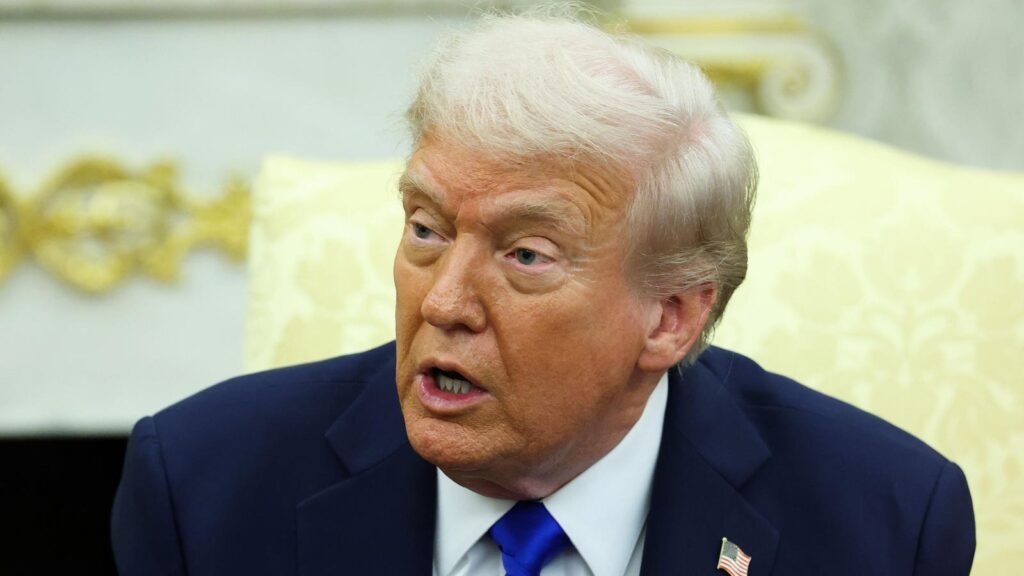President Trump Critiques Time Magazine Cover Photo Following Hostage Release News
In a recent post on Truth Social, former President Donald Trump expressed his dissatisfaction with a cover photo featured on Time Magazine. The image, shot from a low angle with sunlight framing his head, was accompanied by stories commending his involvement in the complex negotiations that led to the release of Israeli hostages and Palestinian detainees.
Time Magazine’s choice of cover photo sparked backlash from Trump.
Getty Images
Key Highlights from Trump’s Reaction
In his early morning post, Trump remarked, “Time Magazine wrote a relatively good story about me, but the picture may be the Worst of All Time.” This sentiment underscores his consistent focus on image and perception.
Trump further criticized the magazine for what he described as the “disappearance” of his hair in the image, humorously noting that it had an object hovering atop his head resembling a “floating crown,” albeit a notably small one. This peculiar detail was attributed to the lighting in the photograph.
On the choice of angle, Trump stated that he “never liked” photographs taken from such a low perspective, labeling it a “super bad picture” that “deserves to be called out.” His emphasis on personal appearance remains a recurring theme in his public persona.
Time Magazine had announced the cover alongside a feature titled “His Triumph,” recognizing Trump’s efforts in crafting a peace plan that some believe could be a significant milestone in Middle East diplomacy.
Trump’s History with Image Critiques
Trump’s discontent with unflattering images is not a new phenomenon. In March, he publicly criticized a portrait displayed in Colorado’s state capitol, calling it “purposefully distorted” and demanding its removal. He remarked, “Nobody likes a bad picture or painting of themselves,” emphasizing a sense of entitlement to favorable representations.
In February 2020, he voiced complaints about pictures that circulated showing him outdoors with windswept hair and a noticeable tan line. He labeled these images as products of “fake news”, asserting they were photoshopped to portray him poorly.
Back in 2017, he expressed discontent over the cover of the book “Unprecedented,” authored by CNN reporters about his 2016 election victory, stating that it featured the “worst cover photo of me.” His ongoing scrutiny of visual portrayal underscores a unique facet of his public image management.
Social Media Reactions to the Time Cover
Following the release of Time’s cover, reactions bubbled up online, with Trump’s allies expressing their disapproval of the magazine’s choice. Kari Lake, a prominent figure and head of the Voice of America, stated that “Time magazine uses the most unflattering photos of President Trump at a moment when they should be honoring him,” labeling the cover as “fake news.”
Moreover, conservative influencer Mario Nawfal criticized the cover, calling it “deliberately terrible” and contrasting it with more flattering images of Democratic figures such as Joe Biden and Kamala Harris.
Context: The Peace Plan and Hostage Release
This controversy coincides with a pivotal moment in Middle Eastern politics. Recently, Hamas released the remaining 20 living hostages held in Gaza, while Israel reciprocated by freeing approximately 2,000 Palestinian detainees, as part of a broader peace plan put forth by Trump during a summit in Egypt. Detailed in Trump’s 20-point peace plan are stipulations for Hamas to relinquish weaponry, the demilitarization of Gaza, and assurances that Israel will not annex or occupy the region, alongside establishing a temporary Palestinian governing committee monitored by an international board.
For more information on the specifics of the peace plan, you can read further details on the BBC.
Conclusion
The clash over Trump’s portrayal in a prominent publication offers insight not only into his character but also into the landscape of modern media and politics. As discussions continue regarding his peace efforts, the images that accompany such narratives will remain divisive topics both in public and digital arenas.


